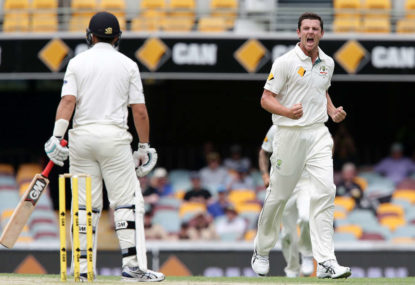WATCH: Freddy Flintoff's son dominates County 2nds game batting exactly like his dad
Check out some of the short-arm pull shots from Rocky Flintoff!

It was short, but in the eyes of many, it was exciting.
The first ever day-night Test match in cricket’s history, contested between Australia and New Zealand at the Adelaide Oval, produced the type of contest – a low-scoring one – that the ground hadn’t seen in a very long time.
The crowds came in their thousands, the audiences came to watch and listen, intrigued to see how this brand new concept, a long-form game played partly under lights with a pink Kookaburra, would work, and work successfully.
There were many trials in domestic first-class cricket, not to mention the constant development and research behind the scenes by all stakeholders from across the world, just to get this exciting concept off the ground.
I watched the online streams, and highlights packages of recent day-night Sheffield Shield games, and what I noticed straight away was that the pink ball was difficult to see even during the day, but especially at night, and that many players also appeared to struggle more than usual, whether they were batting or fielding.
However, I decided to reserve my judgement until I saw the first-ever day-night Test on television between Australia and New Zealand before making my mind up on whether I liked, or loved the concept, and whether it had a future.
I watched just about every moment of all three days. It was not the typical Test match you would see at the Adelaide Oval, a place where you can normally put your mortgage on the contest lasting for the scheduled five days.
It was the first Adelaide Oval Test that did not see one individual score a century since 1993, when the West Indies famously defeated Australia by a single run, the narrowest victory in the history of Test match cricket.
The Adelaide Oval pitch is normally a pitch that is very good for batting for the first three days, before starting to deteriorate on the last two days and allowing for smart, talented spinners, as well as swinging fast bowlers who consistently bowl stump-to-stump, to take hold of the match. It often leads to a dramatic conclusion late on the fifth day.
So why did this Test go completely against the grain of the type of match this ground is typically renowned for?
Most experts and former players believed it was the pitch, and the amount of grass covering it that produced the low-scoring contest.
However, although there was a good coverage of grass, the pitch was a typical Adelaide Oval wicket in terms of its appearance. I have seen more grass at the Adelaide Oval in previous matches, and teams were still scoring 500 runs in their first innings.
This turned my attention to the pink ball, created by embattled sports manufacturer Kookaburra.
This pink creation received huge plaudits from most experts and former players, crediting it for producing what they saw as a fair and balanced contest between bat and ball.
However, I noticed that the ball started to behave in strange ways in comparison to the age of the ball, and how you would expect the ball of a certain age to behave.
As the night sky started to darken, a ball that was already over 40-overs old started to swing in a conventional way, something which is not normal at all in my experiences of watching cricket on screens or live.
Even in England, a place where conventional swing bowling is very common, you wouldn’t normally see the ball, whether it is traditionally red or sporting white, swing in a conventional way at around the 40th over mark, and certainly not all of a sudden if it did.
Adding to this, my initial observation from the day-night Shield games was that the pink ball was difficult to see and players struggled to see the ball more than usual.
This, combined with the unusual behaviour of the pink ball under certain conditions, made it very difficult for even the batsmen with perfect techniques to adapt and perform to their full potential.
The appropriate stakeholders must continue improving all aspects, including the ball, needed to ensure day-night long-form cricket is more like normal Test cricket, relative to the conditions and historical factors of each ground around the world.
Overall, I see a future for day-night Tests going forward, and in terms of the commercial and promotional side of this concept the first match was a resounding success.
However, did this Test match produce a fair and balanced contest between bat and ball, relative to the conditions and historical factors that contests at the Adelaide Oval are normally renowned for?
Not really.
Ryan Eckford recently completed work placement at 1233 ABC Newcastle as part of his studies. He wrote profiles on Newcastle Knights coach Nathan Brown, Newcastle Jets coach Scott Miller, and a piece on his experience in the ABC Grandstand commentary box.